|
Report from
Europe
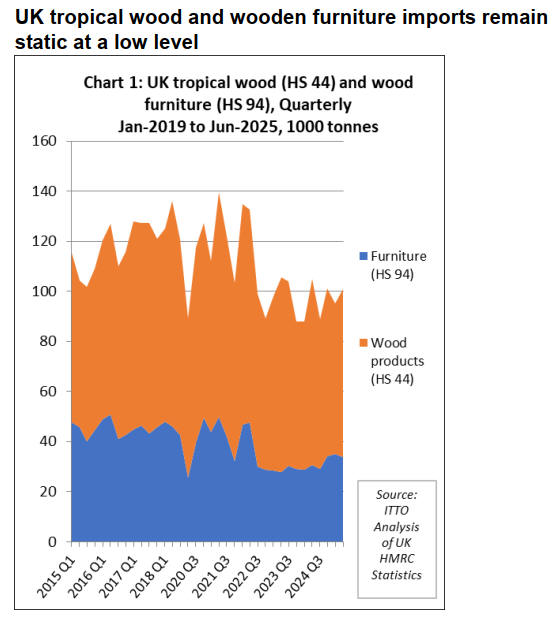
In the first eight months of this year, the UK imported
255,700 tonnes of tropical wood and wooden furniture
products, 1% more than same period in 2024. Import value
in the first eight months this year was US$686 million, 5%
more in nominal terms but only 2% more in real terms (i.e.
taking account of inflation) than the same period in 2024.
Imports were slow in the first quarter this year, down 6%
in quantity terms compared to the final quarter of 2024 but
rebounded by 6% in the second quarter (Chart 1).
UK imports of tropical wood products this year have
essentially continued at the low level maintained since the
end of the COVID pandemic in 2022 and remain around
15% below the pre-pandemic level. While the quantity of
tropical wooden furniture imported into the UK has
increased 13% this year, plywood is down 12% and
joinery, sawnwood and mouldings/decking products have
made only marginal gains of less than 3% against
historically low levels last year.
Tropical products underperformed in UK market this
year
The UK market for tropical wood and wooden furniture
this year has been slower than the wider UK market for
these products. UK import value of wood and wooden
furniture from all supply regions was US$7.56 billion
between January and August this year, 6% more in real
terms compared to the same period in 2024.
The share of tropical wood and wooden furniture products
in total UK imports declined slightly from 9.4% in the first
eight months of 2024 to 9.1% during the same period this
year. This share is now well down on the 11.4% share
achieved in 2022 and the close to 14% share typical before
the COVID pandemic.
Considering the value of UK imports of all wood and
wooden furniture products in the first eight months of this
year, imports from China were, at US$1.77 billion, 10%
more than the same period in 2024. China’s share of total
UK import value was 24% in the first eight months this
year, up from 23% in the same period last year.
Nevertheless, wood and wooden furniture imports from
the EU continue to dominate in the UK market, rising 5%
in the first eight months of this year to US$4.46 billion.
Imports from the EU accounted for 59% of all UK import
value of wood and wooden furniture in the first eight
months of 2025, marginally down on the 59% share in the
same period last year.
The most notable recent trend in the UK market for wood
and wooden furniture was a step change during the
COVID pandemic as the country became generally more
reliant on regional suppliers inside the EU. Following the
UK’s departure from the EU in 2020, this trend ran
contrary to expectations.
UK imports from China are only now just beginning to
recover from a downturn in the immediate aftermath of the
pandemic and to once again eat away at the dominant EU
market position.
However, imports from the tropics have remained broadly
flat at a lower level during the last three years (Chart 2).

Some small positive signs in gloomy UK economy
The economic picture in the UK remains very patchy.
Statistics for the third quarter of the year were quite
gloomy, notably so in construction, a key driver of UK
timber demand, but some forward looking business
indicators showed signs of improvement in October as
some positive news on inflation raised expectations of an
interest rate cut before the end of the year.
Official figures revealed that the UK economy grew by
0.1% in August 2025, up marginally from a revised
contraction of -0.1% in July. Manufacturing was the main
driver of economic growth, which grew by 0.7%. In
contrast, the services sector saw no growth in August,
amid weaker transport and storage activity and retail
output. Construction output fell by 0.3%, partly reflecting
lower repairs and maintenance activity.
The UK Institute of Chartered Accountant’s Business
Confidence Monitor for Q3 2025 stood at -7.3 on the
index, down from -4.2 in the previous quarter. On this
measure, confidence is now at its weakest level since Q4
2022, having fallen for five consecutive quarters. Record-
high tax concerns are the likely cause, squeezing profit
growth, recruitment and investment activity. Muted
domestic sales growth also weighed on sentiment, as firms
were lowering their expectations for the year ahead.
Particularly worrying for the timber sector, sentiment was
most negative among property businesses (-23.2), amid a
challenging housing market and weak commercial
demand.
Data from CoStar, a firm that monitors Real Estate data in
the UK, shows that construction of offices, shops and
warehouses in the country has now fallen to the lowest
level in more than a decade amid rising build costs and
general uncertainty. All commercial sectors have been hit,
with construction across office, retail and industrial sectors
down by 21% to 5.85m sq metres (63m sq ft) in the third
quarter compared with a year earlier.
This data is particularly concerning at a time UK
housebuilding is also slowing. This year is on course to be
the weakest for construction starts so far this century.
Somewhat more positive is data from the UK Office of
National Statistics which shows that total construction
output increased by 0.3% in the three months to August
2025. While new work fell by 0.4% in the three month
period, repair and maintenance grew by 1.3%. The closely
watched purchasing managers’ index (PMI) for the
construction sector gave a reading of 46.2 for September,
still below the 50-mark separating growth from
contraction, but up from 45.5 in August.
In October, the UK’s overall PMI - published by S&P
Global Market Intelligence - also rose unexpectedly to
51.1, up from 50.1 in September, raising hopes that the
economy may have reached a turning point, particularly as
inflation seems on track to hit the Bank of England’s 2 per
cent target. Manufacturing PMI climbed to 49.6 in
October from 46.2 in September, the highest level in a
year. The services PMI, which measures output in a sector
that generates about 80 per cent of UK GDP, rose to 51.1
from 50.8 over the same period.
According to Chris Williamson, chief business economist
at S&P Global Market Intelligence, the rise in the overall
PMI in October implies that “September was a low point
for the economy from which business conditions are
starting to improve”.
Sharp rise in UK imports of tropical wooden furniture
from Viet Nam this year
In the first eight months of this year UK imports of
wooden furniture from tropical countries increased 16% to
US$343 million while import quantity increased 13% to
89,800 tonnes.
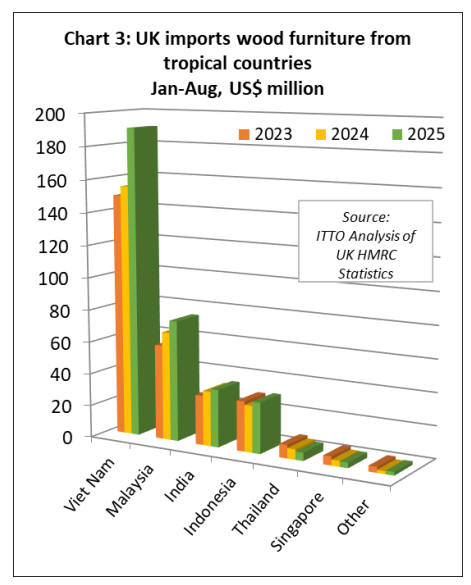
Wooden furniture imports in the eight-month period
increased particularly sharply from Viet Nam (+23% to
US$191 million) and Malaysia (+12% to US$75 million),
building on the momentum that built up in the second half
of last year.
Imports increased at a slightly slower pace from India
(+5% to US$36 million), and Indonesia (+9% to US$32
million). However, imports declined from Thailand (-20%
to US$5.1 million), and Singapore (-7% to US$3.3
million). UK wooden furniture imports were negligible
from all other tropical countries during the first eight
months of this year (Chart 3).
UK imports of wood joinery products from the EU and
Indonesia fell this year
Total UK import value of tropical joinery products
decreased 1% to US$139 million in the first eight months
of 2025, although import quantity increased 3% to 49,100
tonnes. Following a big increase in 2024, imports of these
products from the EU fell 22% to US$28 million in the
first eight months of this year. Imports from Indonesia,
mainly comprising doors, were US$63 million during the
eight-month period, 4% less than the same period last
year.
These declines were partly offset by rising imports of
tropical hardwood joinery products from China (+35% to
US$20 million), Malaysia (+20% to US$19 million), and
Viet Nam (+15% to US$5.7 million) (Chart 4).
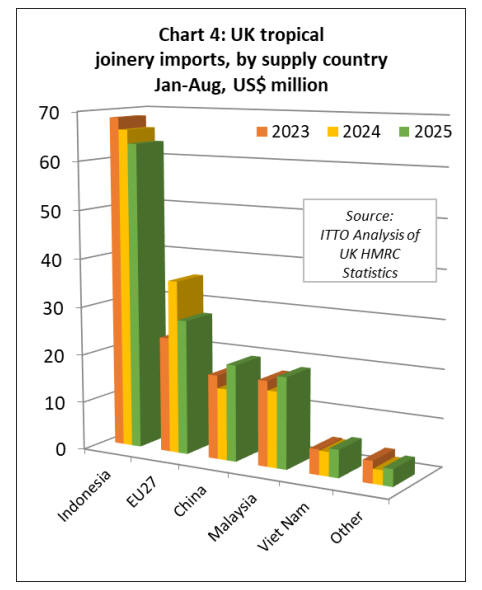
UK imports of plywood shifted from China to Malaysia
this year
In the first eight months of this year, the UK imported
111,500 cu.m of tropical hardwood plywood, 12% less
than the same period last year. Import value fell more
sharply, by 14% to US$67 million.
However, this was mainly due to a decline in imports from
China. Direct UK imports of hardwood plywood from
tropical countries increased 6% to 83,500 cu.m in the
eight-month period. Imports were up 29% to 45,600 cu.m
from Malaysia and increased from zero to 2,000 cu.m
from Singapore. These gains offset declines of 15% to
27,700 cu.m from Indonesia and of 39% to 2,100 cu.m
from Brazil.
Imports from Paraguay were unchanged from last year at
3,300 cu.m. The UK imported 21,700 cu.m of plywood
with an outer layer of tropical hardwood from China in the
first eight months of this year, 49% less than in the same
period last year. However, UK imports of tropical
hardwood plywood from EU countries increased, by 21%
to 6,400 cu.m during this period. (Chart 5).
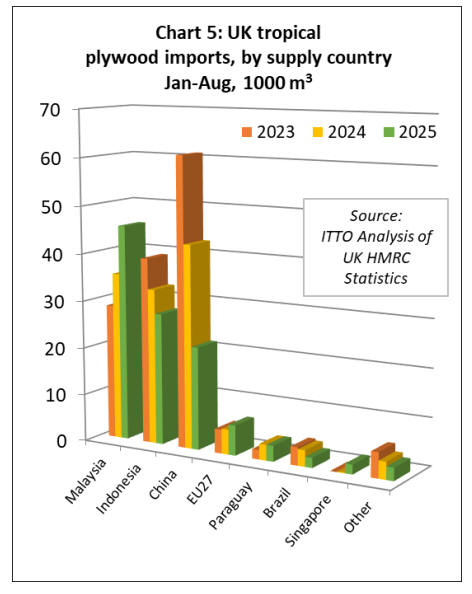
Republic of Congo expands share of UK tropical
sawnwood market
UK imports of tropical sawnwood were 58,000 cu.m in the
first eight months of this year, marginally less than the
58,400 cu.m imported in the same period last year. Import
value was also very close to the same level as last year, at
US$71.2 million, a gain of just 0.2%.
The most notable trend this year has been a sharp rise in
imports from the Republic of Congo which increased
121% to 10,600 cu.m in the first eight months of this year.
A significant increase was also recorded in UK imports
from Malaysia (+27% to 7,500 cu.m).
These gains offset declining imports from Cameroon (-8%
to 19,300 cu.m), Brazil (-11% to 1,600 cu.m), Côte
d'Ivoire (-50% to 1,000 cu.m), and Ghana (-60% to 900
cu.m). Indirect imports from the EU also fell, by 19% to
13,700 cu.m. (Chart 5 above).
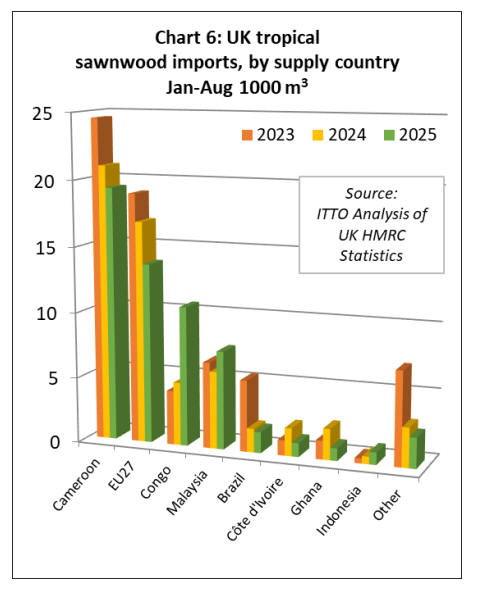
The introduction of the log export ban and shift towards
more kiln dried production by some leading exporters in
the Republic of Congo has been particularly critical to
expansion of the UK market which has no hardwood
processing capacity of its own.
This trend also partly explains the decline in UK imports
of tropical sawnwood from the EU this year as more kiln
dried product is being imported direct from the Republic
of Congo instead of being shipped first to the EU for
drying.
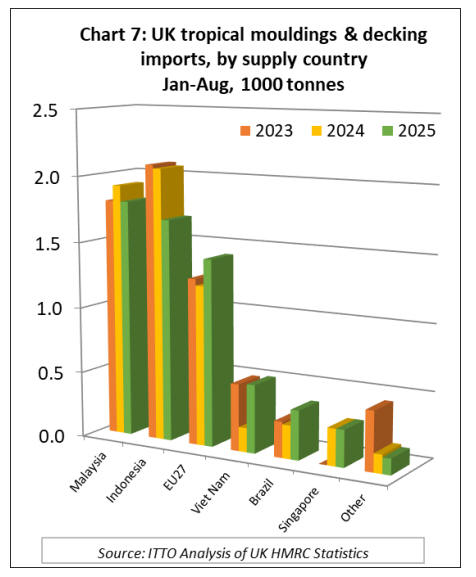
UK imports of tropical hardwood mouldings/decking
increased 2% to 6,200 tonnes in the first eight months of
this year. However, import value fell 0.5% to US$16.7
million.
Import quantity declined from the two largest suppliers,
Malaysia (-6% to 1,800 tonnes) and Indonesia (-18% to
1,700 tonnes). However, imports increased from Viet Nam
(+180% to 500 tonnes) and Brazil (+48% to 400 tonnes).
Imports of tropical mouldings/decking imports from the
EU also increased, by 17% to 1,400 tonnes (Chart 7).
Postponement of EUDR implementation unlikely - EC
publishes proposal to amend regulation
On 21 October, the European Commission (EC) published
its proposal to amend the EU Deforestation Regulation
(COM(2025)652). The EC is no longer proposing a delay
to EUDR and the implementation date remains 30
December 2025.
However, some other specific adjustments to the timeline
for application of the law are proposed, alongside several
“targeted simplifications” designed to reduce obligations
on certain categories of EU operator. The proposal still
needs to be approved by both the European Parliament and
the Council before it can enter into force. The relevant
documents may be accessed here:
See:
https://ec.europa.eu/commission/presscorner/detail/en/ip_25_2464
Two specific adjustments to the timeline are proposed by
the EC:
“Micro and small” EU operators would have until
30 December 2026 to comply. This concession
would apply only to EU operators with net
turnover of up to EUR 10 million and average 50
employees. It would not apply to medium or large
sized operators above these thresholds.
EU Member States will only begin checks on
operators and applying enforcement measures
after 30 June 2026. In the interim, regulators may
issue warnings to operators, accompanied by
recommendations to achieve compliance, where
they “become or are made aware of non-
compliance”, but they wouldn’t apply sanctions.
Overall, the changes now proposed by the EC, even if
passed, fall short of expectations raised in some quarters
following the EC’s suggestion in September that EUDR
would have to be delayed for another year and that the law
may be amended.
The proposed 12 month delay for “micro and small” EU
operators is probably only of limited relevance to
exporters of tropical hardwood products since most
importing companies in the EU are above the size
threshold. Therefore, even with the change they would still
be obliged to collect and enter their due diligence data
onto the EU Information System from 30 December this
year.
The six month delay to enforcement is probably more
significant for the tropical wood industry as it gives more
time for EU importers and their suppliers to finalise and
refine their own data management systems and procedures
without risk of falling foul of the regulation in the first six
months of application.
Other changes proposed to the legislation are designed
almost exclusively to simplify application inside the EU.
The EC is proposing to remove the requirement for so-
called “micro and small primary operators” to submit a
due diligence statement in the information system with
each harvest and instead to submit a “one-time simplified
declaration”. This one-off document would include the
“geolocation or the postal address of all plots of land
where the relevant commodities are produced”.
The EC press statement accompanying the EC proposal
suggests that this “simplification” applies to “micro and
small primary operators in low risk countries worldwide”.
However, its relevance to producers outside the EU is
greatly constrained by the fact that it would only apply to
products which “they (i.e. the forest owners) themselves
produce”. Therefore, logs exported directly by small forest
operators in a “low risk” country might conceivably meet
the requirement, but no product that is processed,
manufactured, or traded by any intermediary outside the
EU.
The change in requirement would therefore, almost
exclusively, be of benefit only to small forest operators
and farmers inside the EU. In fact, EC press release states
that this new category of operator covers “close to 100%
of farmers and foresters in the EU”.
The other major “simplification” proposed, this being
entirely restricted to the internal EU market, is the
introduction of a new sub-category of operator called a
"downstream operator".
Downstream operators would no longer need to undertake
any due diligence or, if a SME, to enter any data on the
EUDR Information System. Their obligation would extend
only to passing on the reference numbers of due diligence
statements or declarations received from their suppliers on
to their customers.
The new “downstream operator” category would capture a
large proportion of existing EU operators under EUDR,
being defined as those which “place on the market or
export relevant products made using relevant products, all
of which are covered by a due diligence statement or by a
simplified declaration".
Instead of requiring due diligence statements to be
prepared at every point of transformation inside the EU
(that is by mills/manufacturers of all types of lumber, pulp,
paper, joinery, furniture etc), as previously required, this
proposed change would reduce the burden on the EU
wood product manufacturing sector.
The EU’s existing non-legally binding guidance was
already heading in this direction, but the introduction of a
new category of ‘downstream operator’ would make
explicit the shift away from requiring transfer of
geolocation data and mandatory due diligence throughout
the supply chain for EU-produced and traded goods.
The next plenary of the European Parliament is 12–13
November 2025 in Brussels and it is likely that the
proposal will be voted on then.
|